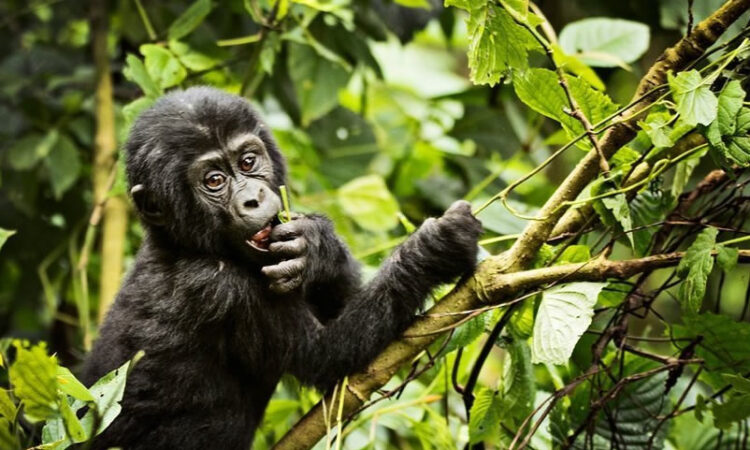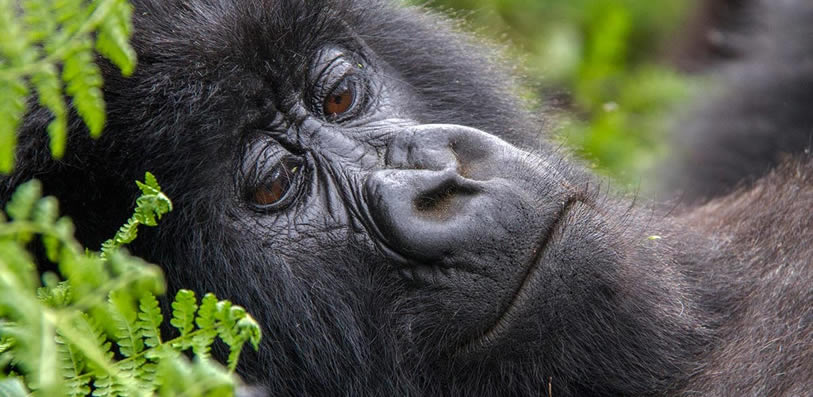What are the chances of seeing Gorillas in Uganda, Rwanda and Congo? Every tourist is anxious about their prospects of encountering mountain gorillas in the wild. Concerns are legitimate, especially given the high cost of gorilla trekking as a pastime. Nothing is definite according to nature’s laws, yet the odds of sighting gorillas are quite high. The high likelihood of seeing monkeys during a walk is due to a number of variables, as we will see later.

Mountain gorillas are only found in three countries: Uganda, Rwanda, and the Democratic Republic of the Congo (DRC). These colossal apes are found in remote sections of the Virunga mountain and the Bwindi impenetrable forest. Gorilla trekking is a fantastic experience that one recalls for the rest of their life because to their enormous size, endangered status, and the pleasure of discovering them.
Mountain gorillas are only found in three nations, as previously stated. They may be found in Uganda’s Bwindi Impenetrable National Park and Mgahinga Gorilla National Park. The primates may be found in Rwanda’s Volcanoes National Park. Virunga National Park is home to the Congo’s mountain gorillas. Uganda is home to half of the world’s mountain gorilla population.
What are the chances of seeing gorillas in Uganda, Rwanda and Congo?
In any of the four national parks, the odds of spotting mountain gorillas are 98%. Because of natural laws and norms, we cannot declare 100%. Every visitor should be aware that if they obtain a gorilla permit, they will be able to observe the primates. More information may be found in an article on the greatest countries for gorilla trekking.
Why chances of seeing gorillas are high in Uganda, Rwanda and Congo?
Gorilla Habituation
This is the process of acquainting wild gorillas with the presence of humans around them. Gorillas are not accustomed to being in the presence of humans. In order to prepare them for visitors, a study team/trackers must first find a suitable wild gorilla group. They then begin analyzing their specific group behavior while also gaining their trust.
Dian Fossey noted that you cannot gain the trust of the group until you begin with the dominant silverback. Once the dominant silverback feels at ease with the presence of the researchers, the rest of the group will follow his lead. The habituation of gorillas takes roughly three years to accomplish. Only habituated gorilla groups are tracked by tourists. As a result, the gang does not run into the deep forest or rush at tourists. This gives travelers one hour to capture photographs and films.
Have a team of professional park rangers and guides.
Gorillas may move quickly from one section of the jungle to another while they feed. Previously, travelers would become disoriented if they ventured too far into the woods. The park authorities believed they might address the situation by dispatching an advance squad of trackers before sunrise to discover the exact position of the primates.
This advance team is aware of where the primates spent the night. They are skilled animal trackers who can detect where monkeys are using clues like as excrement or abandoned nests. Using radio calls or GPS monitoring technologies, the advance team will direct the team escorting visitors to where the primates are. The behind-the-scenes work of advance tracking teams is what increases the likelihood of spotting mountain gorillas.
Allocation of Gorilla Groups.
Families of gorillas reside in various sections of the jungle. Some gorilla populations reside in steep or highly wooded locations, making the travel more arduous. The allotment of gorilla groups is done in such a way that fit travelers seek for groups that live far from the park headquarters.
Elders, those with health issues, or those deemed unsuitable are sent to gorilla groups located near the starting place. During the early morning briefing, gorilla groups are so assigned in such a way that everyone can observe the primates. Even people who are unable to walk can observe gorillas thanks to porters and Sedan chairs.

What are the chances of not seeing gorillas in Uganda, Rwanda and Congo?
It is now nearly impossible to avoid seeing the primates. Even if the designated gorilla family ventures too far into the bush, Park Rangers may easily transport you to another recognized group closer to the park.
However, the activity may be canceled if a natural calamity occurs over which the park management has no control. You must be really unlucky for this to happen during your vacation considering gorilla trekking is available every day of the year. Even during public holidays or when it rains, the action never ceases.
The presence of militias/rebels among the gorilla population poses a risk and may result in the cancellation of gorilla treks in Virunga National Park. In the past, rebel groups were drawn to the deep woods of gorilla parks.
They have been completely eradicated in Uganda and Rwanda. The Congolese government and Virunga National Park administration have done an incredible job of cleaning out the rebels by deploying an army of rangers unseen seen anywhere else. If their scouts spot outsiders approaching the park, they will never allow tourists inside.
If you have an infectious or airborne disease, do not go gorilla trekking. A simple cold or cough can sicken or kill an entire gorilla troop. If park officials discover that you have the flu or a cough, they will ask you to postpone your journey until you have treated the illness. A rescheduling of the activity is usually free, but you will be inconvenienced, especially if you have to delay your journey home.


